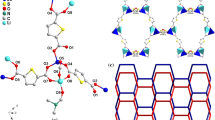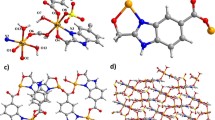Abstract
In the present work, a zinc-based metal–organic framework {[Zn(ddpd)0.5(bipy)0.5]·H2O]}n (1-Zn) (where ddpd = 2,5-di(2′,4′-dicarboxylphenyl)-1,4-difluorobenzene, bipy = 4,4-bipyridine) was synthesized by a solvothermal method. Complex 1-Zn features a three-dimensional (2,4,6)-connected network with {42.62.82}2{44.66.85}{6} topology. Meanwhile, without the assistance of other reagents, complex 1-Zn not only exhibited an exceeded 95% photodegradation efficiency for rhodamine B (Rh B), methyl blue (MB) and methyl orange (MO) within 40 min, but also showed high stability and recyclability. In addition, free radical quenching experiments and electron spin resonance (ESR) spectroscopy verified that the main active species in the photodegradation process were ·O2− and ·OH, and a more in-depth degradation mechanism was further elucidated by density functional theory (DFT) calculations.
Graphical abstract

摘要
在本工作中, 通过简单溶热法合成了锌基金属有机框架{[Zn(ddpd)0.5(bipy)0.5]·H2O]}n(1-Zn) (其中ddpd = 2, 5-二 (2′, 4′-二羧基苯基) -1, 4-二氟苯, bipy = 4, 4-联吡啶) 。在没有其他试剂的帮助下, 光催化剂1-Zn不仅在40分钟内对罗丹明B(Rh B) 、甲基蓝 (MB) 和甲基橙 (MO) 表现出超过95%的光降解效率, 而且还表现出极佳的稳定性和可回收性。此外, 自由基淬灭实验和电子自旋共振 (ESR) 光谱验证了光降解过程中的主要活性物种是·O2−和·OH, 并且在密度泛函理论 (DFT)计算的帮助下进一步阐明了更深层次的降解机制。







Similar content being viewed by others
References
Samsami S, Mohamadizaniani M, Sarrafzadeh MH, Rene ER, Firoozbahr M. Recent advances in the treatment of dye-containing wastewater from textile industries: overview and perspective. Process Saf Environ Prot. 2020;143:138. https://doi.org/10.1016/j.psep.2020.05.034.
Mehmood CT, Tan WY, Chen YZ, Waheed H, Li YW, Xiao YY, Zhong ZY. UV/O3 assisted ceramic membrane reactor for efficient fouling control and DOM transformations in real textile wastewater. Sep Purif Technol. 2022;295:121284. https://doi.org/10.1016/j.seppur.2022.121284.
Rauf M, Ashraf SS. Fundamental principles and application of heterogeneous photocatalytic degradation of dyes in solution. Chem Eng J. 2009;151:10. https://doi.org/10.1016/j.cej.2009.02.026.
Gu L, Shi H, Bian L, Gu M, Ling K, Wang X, Ma H, Cai S, Ning W, Fu L. Colour-tunable ultra-long organic phosphorescence of a single-component molecular crystal. Nat Photonics. 2019;13(6):406. https://doi.org/10.1038/s41566-019-0408-4.
He X, Li H, Wang J, Li Y, Su M, Xu Z. Tunable dual-mode MOF-based composite fluorescent materials: stimuli-responsive and anti-counterfeiting application. Cryst Growth Des. 2021;21(3):1625. https://doi.org/10.1021/acs.cgd.0c01465.
Feng X, Guo N, Chen H, Wang H, Yue L, Chen X, Ng SW, Liu X, Ma L, Wang L. A series of anionic host coordination polymers based on azoxybenzene carboxylate: structures, luminescence and magnetic properties. Dalton Trans. 2017;46(41):14192. https://doi.org/10.1039/C7DT02974H.
Feng X, Zhao J, Liu B, Wang L, Ng S, Zhang G, Wang J, Shi X, Liu Y. A series of lanthanide-organic frameworks based on 2-propyl-1h-imidazole-4, 5-dicarboxylate and oxalate: syntheses, structures, luminescence, and magnetic properties. Cryst Growth Des. 2010;10(3):1399. https://doi.org/10.1021/cg901391y.
Tan G, Jia RQ, Wu WL, Li B, Wang LY. Highly pH-stable Ln-MOFs as sensitive and recyclable multifunctional materials: luminescent probe, tunable luminescent, and photocatalytic performance. Cryst Growth Des. 2021;22(1):323. https://doi.org/10.1021/acs.cgd.1c00956.
Feng X, Shang Y, Zhang H, Liu X, Wang X, Chen N, Wang L, Li Z. Multi-functional lanthanide-CPs based on tricarboxylphenyl terpyridyl ligand as ratiometric luminescent thermometer and highly sensitive ion sensor with turn on/off effect. Dalton Trans. 2020;49(15):4741. https://doi.org/10.1039/D0DT00310G.
Li B, Dong JP, Zhou Z, Wang R, Wang LY, Zang SQ. Robust lanthanide metal–organic frameworks with “all-in-one” multifunction: efficient gas adsorption and separation, tunable light emission and luminescence sensing. J Mater Chem C. 2021;9(10):3429. https://doi.org/10.1039/D0TC05707J.
Fan L, Zhao D, Zhang H, Wang F, Li B, Yang L, Deng Y, Zhang X. A hydrolytically stable amino-functionalized zinc (II) metal-organic framework containing nanocages for selective gas adsorption and luminescent sensing. Microporous Mesoporous Mater. 2021;326:111396. https://doi.org/10.1016/j.micromeso.2021.111396.
Wang HS, Wang YH, Ding Y. Development of biological metal–organic frameworks designed for biomedical applications: from bio-sensing/bio-imaging to disease treatment. Nanoscale Adv. 2020;2(9):3788. https://doi.org/10.1039/D0NA00557F.
Qin JH, Qin WJ, Xiao Z, Yang JK, Wang HR, Yang XG, Li DS, Ma LF. Efficient energy-transfer-induced high photoelectric conversion in a dye-encapsulated ionic pyrene-based metal-organic framework. Inorg Chem. 2021;60(24):18593. https://doi.org/10.1021/acs.inorgchem.1c02624.
Yang XG, Lu XM, Zhai ZM, Qin JH, Chang XH, Han ML, Li FF, Ma LF. π-type halogen bonding enhanced the long-lasting room temperature phosphorescence of Zn (ii) coordination polymers for photoelectron response applications. Inorg Chem Front. 2020;7(11):2224. https://doi.org/10.1039/D0QI00191K.
Cui Y, Song T, Yu J, Yang Y, Wang Z, Qian G. Dye encapsulated metal-organic framework for warm-white led with high color-rendering index. Adv Funct Mater. 2015;25(30):4796. https://doi.org/10.1002/adfm.201501756.
Wang X, She P, Zhang Q. Recent advances on electrochemical methods in fabricating two-dimensional organic-ligand-containing frameworks. SmartMat. 2021;2(3):299. https://doi.org/10.1002/smm2.1057.
Wang H. Nanostructure@metal-organic frameworks (MOFs) for catalytic carbon dioxide (CO2) conversion in photocatalysis, electrocatalysis, and thermal catalysis. Nano Res. 2022;15:2834. https://doi.org/10.1007/s12274-021-3984-9.
Zhang G, Pastoriza-Santos I, Pérez-Juste J, Liz-Marzán LM. Plasmonic metal-organic frameworks. SmartMat. 2021;2(4):446. https://doi.org/10.1002/smm2.1047.
Zhao X, He X, Hou A, Cheng C, Wang X, Yue Y, Wu Z, Wu H, Liu B, Li H, Shen J, Tan C, Zhou Z, Ma L. Growth of Cu2O nanoparticles on two-dimensional Zr-ferrocene-metal-organic framework nanosheets for photothermally enhanced chemodynamic antibacterial therapy. Inorg Chem. 2022;61:9328. https://doi.org/10.1021/acs.inorgchem.2c01091.
Dai YT, Xiong YJ. Control of selectivity in organic synthesis via heterogeneous photocatalysis under visible light. Nano Res Energy. 2022;1(1):e9120006. https://doi.org/10.26599/NRE.2022.9120006.
Gu JW, Peng Y, Zhou T, Pang H, Yamauchi Y. Porphyrin-based framework materials for energy conversion. Nano Res Energy. 2022;1(1):19120009. https://doi.org/10.26599/NRE.2022.9120009.
Mi X, Sheng D, Ye Yu, Wang Y, Zhao L, Lu J, Li Y, Li D, Dou J, Duan J. Tunable light emission and multiresponsive luminescent sensitivities in aqueous solutions of two series of lanthanide metal–organic frameworks based on structurally related ligands. ACS Appl Mater Interfaces. 2019;11(8):7914. https://doi.org/10.1021/acsami.8b18320.
Peikert K, Hoffmann F, Fröba M. Fluorine magic: one new organofluorine linker leads to three new metal-organic frameworks. CrystEngComm. 2015;17(2):353. https://doi.org/10.1039/C4CE00408F.
Blatov VA, Shevchenko AP, Proserpio DM. Applied topological analysis of crystal structures with the program package ToposPro. Cryst Growth Des. 2014;14(7):3576. https://doi.org/10.1021/cg500498k.
Yang N, Chen D, Cui P, Lu T, Liu H, Hu C, Xu L, Yang J. Heterogeneous nanocomposites consisting of Pt3Co alloy particles and CoP2 nanorods towards high-efficiency methanol electro-oxidation. SmartMat. 2021;2(2):234. https://doi.org/10.1002/smm2.1032.
Zhu SR, Liu PF, Wu MK, Zhao WN, Li GC, Tao K, Yi FY, Han L. Enhanced photocatalytic performance of BiOBr/NH2-MIL-125 (Ti) composite for dye degradation under visible light. Dalton Trans. 2016;45(43):17521. https://doi.org/10.1039/C6DT02912D.
Li RF, Zhang H, Hong MZ, Shi JG, Liu XF, Feng X. Two Co (ii)/Ni (ii) complexes based on nitrogenous heterocyclic ligands as high-performance electrocatalysts for the hydrogen evolution reaction. Dalton Trans. 2022;51(10):3970. https://doi.org/10.1039/D1DT03814A.
Naik SS, Lee SJ, Yeon S, Yu Y, Choi MY. Pulsed laser-assisted synthesis of metal and nonmetal-codoped ZnO for efficient photocatalytic degradation of Rhodamine B under solar light irradiation. Chemosphere. 2021;274:129782. https://doi.org/10.1016/j.chemosphere.2021.129782.
Li JY, Ma AQ, Li HF, Dong YH, Gao YQ. Tunable micromorphology and photocatalytic properties of monoclinic BiVO4 prepared by bionic template method. Chin J Rare Met. 2020;44(9):912. https://doi.org/10.13373/j.cnki.cjrm.xy19060008.
Dong JP, Shi ZZ, Li B, Wang LY. Synthesis of a novel 2D zinc (II) metal–organic framework for photocatalytic degradation of organic dyes in water. Dalton Trans. 2019;48(47):17626. https://doi.org/10.1039/C9DT03727F.
Yang SJ, Xu YL, Gong WP, Huang YK, Wang GH, Yang Y, Feng CQ. Photocatalytic degradation of organic dyes with H3PW12O40/TiO2–SiO2. Rare Met. 2016;35(10):797. https://doi.org/10.1007/s12598-015-0521-6.
Pan Y, Ding Q, Xu H, Shi C, Singh A, Kumar A, Liu J. A new Zn (ii)-based 3D metal–organic framework with uncommon sev topology and its photocatalytic properties for the degradation of organic dyes. CrystEngComm. 2019;21(31):4578. https://doi.org/10.1039/C9CE00759H.
Wu J, Li B, Zhong H, Qiu S, Liang Y, Zhuang X, Singh A, Kumar A. Fluorescence sensing and photocatalytic properties of a 2D stable and biocompatible Zn(II)-based polymer. J Mol Struct. 2018;1158:264. https://doi.org/10.1016/j.molstruc.2018.01.028.
Çiftlik A, Tce GS, Sahin O, Semerci F. Two-dimensional metal–organic framework nanostructures based on 4, 4′-sulfonyldibenzoate for photocatalytic degradation of organic dyes. Cryst Growth Des. 2021;21(6):3364. https://doi.org/10.1021/acs.cgd.1c00152.
Cheng YH, Chen J, Che HN, Ao YH, Liu B. Ultrafast photocatalytic degradation of nitenpyram by 2D ultrathin Bi2WO6: mechanism, pathways and environmental factors. Rare Met. 2022;41(7):2439. https://doi.org/10.1007/s12598-022-01984-5.
Yi SS, Wulan BR, Yan JM, Jiang Q. Highly efficient photoelectrochemical water splitting: surface modification of cobalt-phosphate-loaded Co3O4/Fe2O3 p-n heterojunction nanorod arrays. Adv Funct Mater. 2019;29(11):1801902. https://doi.org/10.1002/adfm.201801902.
Tan G, Jia RQ, Zhao X, Guo YQ, Zhang LL, Wang XH, Wang JG, Feng X, Li B, Wang LY. Fabrication of two isomorphic and hyperstable rare earth-based metal-organic frameworks with efficient ratiometric probe and photocatalytic performances. Inorg Chem. 2022;61(30):11866. https://doi.org/10.1021/acs.inorgchem.2c01619.
Shi H, Zhao Y, Fan J, Tang Z. Construction of novel Z-scheme flower-like Bi2S3/SnIn4S8 heterojunctions with enhanced visible light photodegradation and bactericidal activity. Appl Surf Sci. 2019;465:212. https://doi.org/10.1016/j.apsusc.2018.09.164.
Cheng H, Huang B, Dai Y, Qin X, Zhang X. One-step synthesis of the nanostructured AgI/BiOI composites with highly enhanced visible-light photocatalytic performances. Langmuir. 2010;26(9):6618. https://doi.org/10.1021/la903943s.
Acknowledgements
The authors gratefully acknowledge the financial support of this work by the National Natural Science Foundation of China (No. U1904199), the Program for Science & Technology Innovation Team in Universities of Henan Province (No. 21IRTSTHN004), the Program for Science and Technology Innovation Talents at the University of Henan Province (No. 22HASTIT007), Science Foundation for Excellent Youth of Henan Province (No. 212300410064), the Young Backbone Teachers in Colleges and Universities of Henan Province (No. 2018GGJS119) and Nanyang Normal University.
Author information
Authors and Affiliations
Corresponding authors
Ethics declarations
Conflict of interests
The authors declare that they have no conflict of interest.
Supplementary Information
Below is the link to the electronic supplementary material.
Rights and permissions
Springer Nature or its licensor holds exclusive rights to this article under a publishing agreement with the author(s) or other rightsholder(s); author self-archiving of the accepted manuscript version of this article is solely governed by the terms of such publishing agreement and applicable law.
About this article
Cite this article
Tan, G., Guo, YQ., Zuo, LY. et al. Synthesis of zinc-based metal–organic framework as highly efficient photocatalyst for decomposition of organic dyes in aqueous solution. Rare Met. 42, 1205–1213 (2023). https://doi.org/10.1007/s12598-022-02184-x
Received:
Revised:
Accepted:
Published:
Issue Date:
DOI: https://doi.org/10.1007/s12598-022-02184-x




